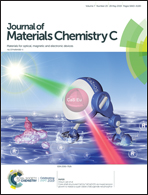Enhanced up-conversion luminescence and optical temperature sensing in graphitic C3N4 quantum dots grafted with BaWO4:Yb3+,Er3+ phosphors
Abstract
In this study, we report a novel up-conversion (UC) material from graphitic C3N4 (g-C3N4) quantum dots (QDs) grafted with BaWO4:Yb3+,Er3+via a solvent-free thermal- and crystalline-cutting method. The g-C3N4/BaWO4:Yb3+,Er3+ composite presents enhanced UC emission under 980 near-infrared (NIR) light compared to that of BaWO4:Yb3+,Er3+, which is attributed to the efficient energy capture of the non-radiative transitions from the higher excited energy level of [2F7/2, 1B(1T2)] to the lower energy level of [2F7/2, 1E(1T2)] assisted by the energy level of the g-C3N4 QDs. We investigate the thermal properties of the two green UC emissions with coupled levels of 2H11/2/4I15/2 and 4S3/2/4I15/2 for Er3+ between 293 and 393 K as an optical thermometry sensor via the fluorescence intensity ratio technique. Such composite materials with enhanced UC luminescence can be used in the field of self-calibrated and highly sensitive optical thermometers to monitor the temperature changes with a maximum relative sensitivity of 1.47% K−1 at 393 K. The results indicate that g-C3N4 QD grafted UC systems can act as promising candidates for use as optical thermometers.



 Please wait while we load your content...
Please wait while we load your content...